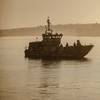The events of September 11 have changed the world forever. The effects of terrorism are now being felt in all industries and all corners of the world. However, terrorism is not as new to the shipping industry as it is to many other industries. Maritime Terrorism and piracy have been a concern of mariners forever. However, the modern pirate is much more sophisticated and far more violent. On October 30 the Tamil Tiger's Maritime branch, the Sea Tigers attacked The M.T. Silk Pride with a suicide bombing attack at sea off the northern tip of Sri Lanka, similar to the attack against the U.S.S. Cole. Fortunately, The damage doesn't appear to be quite as bad
Many believe ships will be the next form of transportation used to facilitate the next mass casualty attack. This may or may not be the case but one thing can be certain: Ships, their cargo, their funds, and their crews are beneficial to the needs of terrorist organizations. As the United States and her allies continue to seize terrorist assets, there will be an increasing need for funds. The ransom of a ship and or it's crew can yield large dividends to terrorist organizations. Not only could terrorists use the cargo to sell on the black market or use it in their war effort as the Tamil Tiger's have, but the need for weapons and equipment could enable other organized crime factions to steal cargo and sell it to the terrorists. This scenario increases the pool of adversaries to the shipping industry.
Realizing the various hazards to vessels at sea, many shipping executives are left to wonder what can be done to prevent maritime terrorism and how to establish increased security and still maintain a decent profit margin. The answer to these problems lies in the ability to train current crews how to recognize areas where the feasibility of a ship boarding or other forms of attack are likely, how to avoid becoming a target, and what measures to take if an attempted boarding occurs. Insurance companies have sharply raised their rates in the Middle East due to the current situation. One would think insurance companies would provide a rate discount to companies training their crews in anti-piracy measures. This savings would decrease the number of shipping incidents and allow shipping companies to provide safety to their crews with the money saved on insurance rates. Having said this, how do we protect our vessels at sea?
To protect vessels at sea one must first understand the terrorist mind-set. The terrorist is rarely looking for your ship specifically. Terrorists are generally looking for the ship that is the easiest target within the parameters of their particular objectives. This means that if a ship takes precautionary measures to strengthen it's security at sea, the terrorist will seek out a different ship. Attacking ships is the job of the terrorist. He or she sits all night and waits for the ship providing the perfect opportunity. This is why prevention training is the best most affordable deterrent. What are some precautionary measures? First of all, by training crews to recognize places where ships are vulnerable, the crew can be on a higher state of alert at these points.
Ships can develop a zig-zag pattern in places where the shipping lane is wide enough. This makes it more difficult for attackers to board. Although crews are usually small and do not have the manpower to maintain watch at all times, setting a watch between 2300-0500 can greatly deter attacks. Remember, crewmembers must watch the stern! On tankers, the sides are also easy to board. Ship radar cannot be relied on to see potential attackers because many low profile vessels do not show up on radar. Attackers are most vulnerable when they are in transition between the attack craft and the commercial vessel. This is the best time to attempt counter-piracy efforts. Set up an alarm code that enables all available personnel to hear the alarm and respond to the attack. Train crewmembers where to go and what to do. Although firearms are a problem in many ports, there are other non-lethal and lethal means of deterring potential attackers. The fire hose of course is a non-lethal option but generally a poor idea against armed attackers. However, spotlights can greatly aid non-lethal efforts. High candlepower lights can make it difficult for attackers on the climb to see. They are also blinded if trying to shoot from the attack vessel. If they are able to actually board the ship, their eyes will not be adjusted to the lower light levels, giving crewmembers another advantage.
The best way to use spotlights however is to spot potential attackers before they are in boarding range. Often times the fact that they are spotted may remove their element of surprise and deter them from attacking. There are many other methods that are inexpensive yet effective if used properly and creatively. The best first step is to have professionals train your crew. Preferably professionals who understand what it is like to attack a vessel, not just experienced in providing security.
Featured videos

Inmarsat Enhances Service to Drive Digitalization

Tracking Foreign Vessels Working in the U.S. Jones Act Market

Inside the Electrified Truckable Tug
Subscribe for
Maritime Reporter E-News
Maritime Reporter E-News is the maritime industry's largest circulation and most authoritative ENews Service, delivered to your Email five times per week









